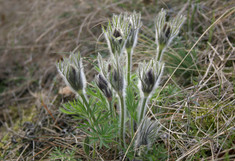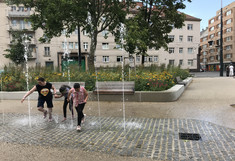Horticultural aspects and use of plants in urban green areas
Contemporary planting design concepts have to fulfill aesthetic, ecological and social functions. Sustainability and bio economy in ornamental plant use are particularly important against the background of current global warming, both in public green spaces and in private gardens.
Therefore, part of the horticultural research relates to application-oriented studies of eastern Austrian or Pannonian wood edge-, semi-arid- and dry grass-vegetation. The results are suitable seed mixtures in combination with plantings of cultivated herbaceous species for public green spaces in Lower Austria or design variants of annuals and perennials in combination with small shrubs and trees.
The adaptation of plantings to increasingly extreme site conditions in the settlement area often affects topics of urban design trends such as low care management of squares and traffic green, mobile gardens or rainwater management. Intensive use as well as extreme heat and precipitation in urban areas require survival artists among the plants - the Austrian steppe vegetation is therefore of particular horticultural interest, but also plant species from far origins. For a long-term aspect of urban greenery which is aesthetic and vital, suitable plants and planting concepts are decisive. With proven knowledge and an understanding of the dynamics of plant communities, planners decide on the quality of plantings - starting with the planning effort and the atmospheric appearance to the maintenance interventions necessary for long-term preservation.
Energy Globe Award 2020 Sustainable and innovative perennial plantings among the best environmental projects from Upper Austria!
With the project “Between Garden and Landscape” as part of the State Garden Show 2019 in Aigen-Schlägl, the BOKU project team Sabine Plenk (horticulture), Barbara Brandstätter and Marlis Rief (landscape architecture) created a nomination for the three final entries in the earth category. A clear statement against the growth of asphalt surfaces and the impoverishment of our green spaces in residential areas!
As part of an organic-certified garden show for the first time ever, the three plant planners focused on climate-adapted, species-rich and low-care greening for special use in public municipal open space. The landscape with its location factors, sustainably produced plant material and a resource-saving cycle thinking in plant culture formed the framework for planting design interventions on a total area of 2000 m². An expanded understanding of the origin of the selected species, the plant-related dialogue between the familiar and the new, the useful and the beautiful, and the seasonal experience of growth, flowering and ripening were important cultural and social components.
The plantings went into public use after the garden show. This offers the rare opportunity for a long-term scientific observation of the development of the population and maintenance management in practice.
The project with its special solutions in the sustainable use of plants sets an important example against the increasing soil sealing and the heating of urban spaces. The plant concepts are suitable for use in squares, in parks, along paths and streets, in parking lots, in residential complexes and even in private garden areas.




